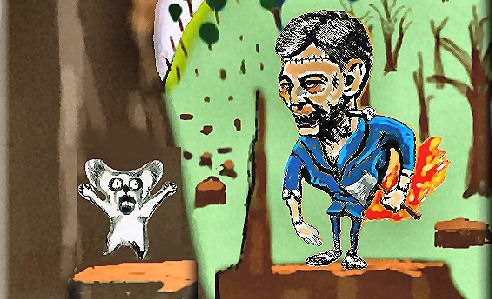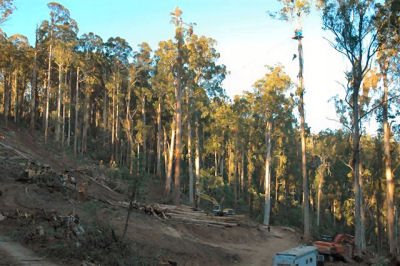Greens, logging, forest fires and malaria
I see that poor old Wilson Tuckey is ('No fuel, no fire' policy must be enforced: Wilson Tuckey, Farm Weekly, 11/02/2009)frothing at the mouth again over trees.
He just cannot see the point of them. Perhaps desperate for company, he's got the attention of the media with the usual dog-whistles. And the media take advantage of this desperate old pollie; they are always on the hunt for conflict, especially if they can hang it onto a raw bona fide tragedy.
Of course, our media wouldn't want to look at the big picture, would they, or that just might mean they would have to stop barracking for growth, suburbs on newly cleared bushland, continuous population growth and a thimble-full of very expensive water per person on the driest continent in the world (apart from Antarctica).
What causes forest-fires? Apart from record heat-waves, interference with forests causes them.

Sustainable forestry in Victoria
Fire-stick farming
When stone-age people learned how to use fire, they probably nearly set the world on fire and permanently altered climate. So the Australian aborigines were probably not unique in what they are thought to have done with their 'fire-stick farming', assisting a drying of the continent which was perhaps already in train. (Ref. Mary White, After the Greening, the Browning of Gondwanaland, Kangaroo Press 1994; Peter Andrews, Australia on the Brink, and Tim Flannery, The Future Eaters) Some people think that the Australian Aborigines greatly reduced Australia's carrying capacity by getting rid of the earlier, wetter forests, and promoting eucalypts and acacias.
But the Aborigines had nothing on Europeans. In the early years, the only voluntary visitors to these shores were natural scientists and artists. Then along came the gold-rush, erasing entire forests for building, heating and cooking materials. The gold-rush permanently impoverished many areas in Victoria, botanically and zoologically and altering their rainfall and hydrology. Today, in such places, still pitted with old mines, thin trees struggle, there is virtually no topsoil, and massive evaporation.
European Australians have been interfering with forests by logging for years.
In a country that was already dry, we have proceeded like a race of termites. Those lovely little wooden houses in Brisbane stand where a great big forest once stood. Same story everywhere you find those cute little wooden houses. At first they have ornate wooden lace decorating them. Then they become plainer and smaller. You know that the forests ran out when the houses are made of brick. You go to a wilderness area to admire the trees, but they are only a tenth of the size of the giants that Europeans took down and exported back to England. The fig trees in Cairns are bigger than the trees in the Daintree.
Sustainable Logging

We hear all about sustainable logging; just a little bit here, just a little bit there...
It all exposes the land to the sunlight and begins the drying.

Even in a huge forest like this
The areas which succumbed to bush-fires in Victoria this year have been logged on and off for years.
And plantations are full of inflammable pines.
Apart from being wrong, blaming the 'greens' (some amorphous group designated the Enemy) overlooks just a few other factors.
Some inconvenient factors
The heat - global warming - exacerbated by land-clearing
The government forced population-growth that has overshot a water-supply which would have seen us through at 17m or less.
Result: a lot of dry, shadeless gardens - no defense against fire
The building of suburbs next to forests
The reduction of water to natural landscapes, for diversion to human industry
The reduction of water from suburbs, for diversion to industry.

The hydrological cycle - note the role of trees in causing rain and keeping water in the soil
We have to moisten our soils and our forests to mitigate the drying and to cool areas locally. Clearing land increases heat and fire risk. Houses can be rebuilt under the earth or they will need to be moved away from forests and the government must stop importing people to increase the size of this population, the size of which is already causing unsustainable demand on water which has now probably claimed lives.
Here is what logging does to forests:
Source: Woods Hole Research Centre, "Fire and Savannization"
Every year, accidental understory fires damage a large percentage of Amazon forest. This is the phenomenon we have called 'cryptic deforestation' (Nepstad 1999). These escaped fires travel slowly (10-20 meters an hour) and only reach a few inches in height, but they can be quite destructive to understory vegetation and kill many larger trees. Once a forest has burned, increased leaf shedding, an abundance of branches and other coarse fuel enhance its fuel load, and an open canopy ensures the fuel will be dry enough to burn. Since settlement is typically a one-way process, the ignition source - humans - is there to stay, and successive burns tend to be more intense and destructive.
Cryptic deforestation due to forest fires and logging may affect as much forest area as deforestation in most years — and even more during periods of prolonged drought. For instance, during El Niño years, up to 25,000 km2 of Brazilian forests may be affected by fire."
Clearing forests a cause of malaria; withholding DDT is a red herring
Oh, and in case you thought that not using DDT caused mosquito epidemics, consider this:
Mosquito epidemics can be caused by clearing forests. Preferred oviposition sites for anopheles are small temporary pools in full sunlight Many mosquitos need to be exposed to sunlight to harden their wings. These conditions were not so often possible when they lived in pools in rich forests, below tall trees and understory, which blocked out the light. Malaria epidemics, through history, occurred with the clearing of forests.[1] And so did soil depletion and the transformation of green and pleasant places into hot deserts.[2]
[1]References for Malaria:
Robert S. Desowitz, New Guinea Tapeworms and Jewish Grandmothers,W.W. Norton and company, New York, London and Richard Carter and Kamini N. Mendis, “Evolutionary and Historical Aspects of the Burden of Malaria,” Clinical Microbiology Reviews, October 2002, p. 564-594, Vol. 15, No. 4, 0893-8512/02/$04.00+0, DOI: 10.1128/CMR.15.4.564-594.2002, American Society for Microbiology, http://malaria.wellcome.ac.uk/doc_WTD023991.html. (For further information, the authors are linked to the following: University of Edinburgh, Division of Biological Sciences, ICAPB, Ashworth Laboratories, Edinburgh EH9 3JT, United Kingdom,1 Roll Back Malaria Project, World Health Organization, Geneva 27, Switzerland.)
See also www.tulane.edu/~wiser/malaria/Malaria-VectorBiology.ppt
[2] References for Forests and soil loss: John Perlin, A forest journeyThe Countryman Press, Woodstock, Vermont, 2005 and David Montgomery, Dirt, the Erosion of Civilisations, University of California Press, 1997.

Recent comments